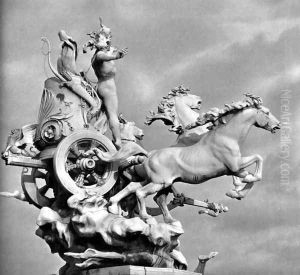Recipon Paintings
Louis-Charles Recipon was a French artist primarily known for his work as a sculptor. Born on February 22, 1860, in Paris, France, Recipon was a part of the vibrant artistic culture of the late 19th and early 20th centuries. His father, Victor Recipon, was also a sculptor, which provided a creative environment for Louis-Charles from a young age. Despite the potential influence of his father, there is limited information on his early training and the development of his artistic style.
Throughout his career, Recipon gained a reputation for his skill in creating grand, ornamental sculptures. His works were often characterized by their dramatic forms and elaborate detail, which were in keeping with the Beaux-Arts tradition that was prominent in France during his lifetime. This style emphasized classical forms and techniques, and it was frequently associated with the architecture and decorative arts of the French Third Republic.
One of Recipon's most notable contributions was his work for the 1900 Paris Exposition Universelle, an event that marked the turn of the century and showcased the height of French cultural and artistic achievements. Recipon created several monumental sculptures for the Pont Alexandre III, one of Paris's most iconic bridges, named after Tsar Alexander III to symbolize the Franco-Russian Alliance. His quadrigas, which are chariot sculptures drawn by four horses, are situated at the bridge's entrances and remain some of the most recognizable features of the bridge today.
Louis-Charles Recipon's artistic legacy is closely tied to the ornamental and public art of the Belle Époque, the period of French history characterized by optimism, peace, economic prosperity, and technological, scientific, and cultural innovations. His works continue to be admired for their embodiment of the grandeur and elegance of this era. Recipon passed away on October 26, 1924, in Paris, leaving behind a body of work that still resonates with the artistic and cultural values of his time.
